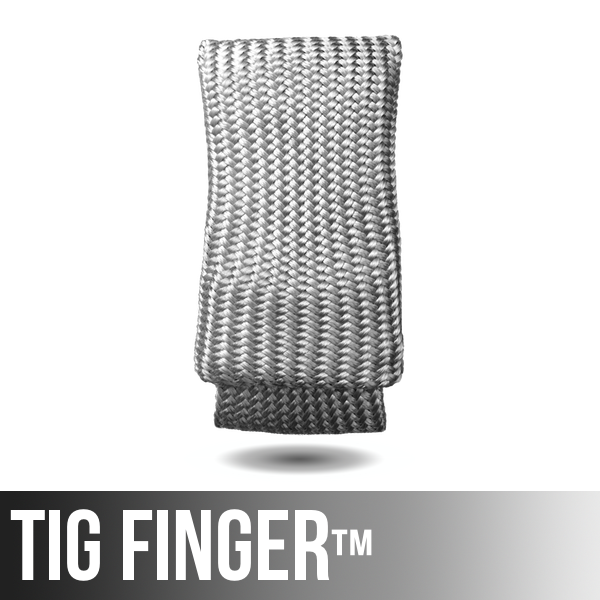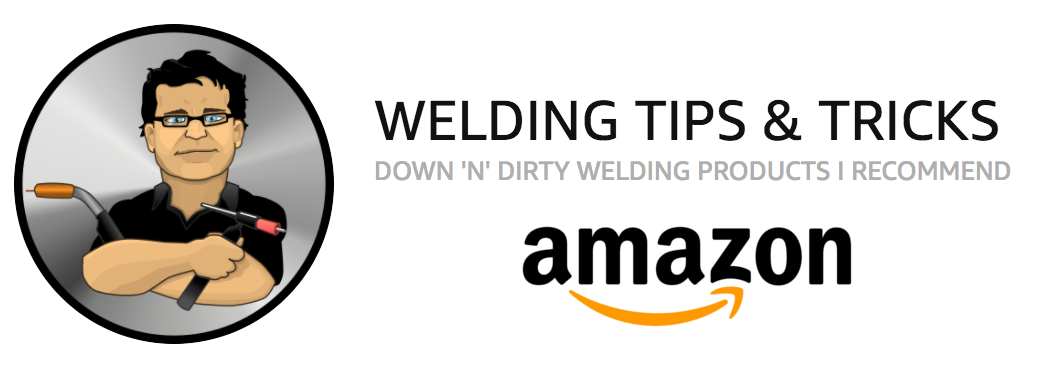Video Transcript:
TIG Welding Practice on Lap Joints
Today we’re TIG welding some carbon steel lap joints. Roughly .120 thick. That’s three millimeters thick. We’ll talk a little bit about filler metal size, gas lenses, and why the second side usually welds worse than the first side. Let’s get into it.
I had some drops from cutting some of this material for a previous video, so I thought maybe I’ll just use these little 2 inch by 2 inch pieces and make a little lap joint video, kind of putting them cattywampus like this. I’m getting little fusion tacks on the corner, just pumping the pedal real quick and getting a small tack. A lot of times I’ll use a torch switch for little tacks like this and use 1-1/2 to 2 times the amperage that I would use to weld something with, and just pop them with a real quick burst tack, but I’m using a foot pedal here. I don’t have it set real high amperage, about 125 amps. Just getting really quick fusion tacks on this thing before I start experimenting in welding them out.
I’m starting off using a number 6 gas lens cup. This is a 17 style torch, but I’ve got a number 6 Stubby gas lens kit on it, and I’m doing a little fusion pass. No filler metal for this first one. You’ve got to keep a tight arc in order to make that run good, and it’s a really good practice for doing that, for keeping a good tight arc. In just a second I will show what happens when you don’t hold a nice tight arc. Not the end of the world, but there’s a huge difference in what I just did there and in using a little bit too long of an arc.
Here’s your little bit too long of an arc. You can see how it’s washing up and melting some of the corner off, and there may not be anything wrong with that, but if you’re trying to do a nice clean little small pass, then that’s not exactly it. I’ll weld over top of that at some point in time. I’m going to let it cool off. I’m going to weld the rest of these with filler metal, starting off using 1/16 inch diameter ER70S-6 filler metal. To me that’s about the right size for this type joint. Some people would use a .045. Some people would use a 3/32 for this joint, but I think a 1/16 is good for me.
It all depends on whether or not you want to take that fillet all the way up to the edge, to the corner, and I usually do. I’ve just seen a lot of welds crack by being too small and therefore having too small of a throat size, so on something like this I usually like to make the fillet weld complete, like all the way up to the corner and then even feed a little bit of rod where it’s not too concave. I think that’s a good smart thing to do for serviceability and longevity of the weld. I got a little bit carried away with the heat there, and so it washed up a little bit too far onto the corner. You can see that right there. So I’ve got to be careful on that and dial things in a little bit better.
Part of that’s because I probably didn’t let it cool very long, and then that weld was a little bit warm already when I lit up on it. I’ll pay attention to that on this one and try to really just watch that edge and work the foot pedal, work the filler metal addition to where it just washes up to the edge. That’s what I like. Did a little bit better job on that one.
This is kind of a nice little practice joint here, or practice exercise. It kind of looks cool when you get done, you use little small pieces, you have to change direction, position the piece where you get a good line of sight on the weld, which is important when you’re learning how to weld. You’ve got to learn how to get a good line of sight, learn how to be comfortable, position your hands, etc. It’s all about being comfortable.
I’m going to get a little left hand practice here as well. I don’t weld left handed much. That first one didn’t go great, not great at all. So I’ll do another one here and I’ll just keep going. That second one’s just a little bit better, and then by the third one things are actually kind of feeling a little bit normal again, getting a little bit better. Good to get some left hand practice from time to time. I’m set at 120 amps here, and sometimes I’m using almost the full pedal. With the 1/16 filler metal here, you’ll see it tops out at I think 117 amps. So in a minute it will go up. It just depends on where you are in the joint and how long you let the previous weld cool before you light up. That’s 117 amps right there. I set the machine 120, I was not quite full pedal.
In just a second, I will go down in filler metal size to .045. When I do that, it will take a little bit less amperage to weld the same joint. That’s pretty typical. So I put the camera on the readout here again, and using .045 filler metal, it took about 10 amps less, so it topped out at 107, 108, something like that. That’s pretty typical. When you’re feeding filler metal in there, every time you dab the rod it chills the puddle, and so if I’m using a smaller filler metal it doesn’t chill the puddle as much. Sometimes it takes a little bit less amperage to weld. That’s something to think about. I know a lot of guys who would use .045 filler metal for this joint, but I use 1/16. I find it’s a pretty good size for me. It’s an individual thing. It depends on your goals. It depends on the end result. Do you want to have a full 1/8 fillet on that thing or do you want to just have a weld?
So we’ll do the back side now, and now it gives us an opportunity to talk about this oxidation on the back side. See all that scaliness right there? Everything’s kind of heat-tinted a little bit. The heat tint is not going to be such a big deal, because it’s just barely blue, but that scaly oxidation is a problem to weld over. I mean, it’s not the end of the world, but it doesn’t weld good if you don’t do something to prevent it. So I’m using this little CK17 style torch with a Stubby gas lens here, and I’m going up to a number 7 cup now. I’ll weld for a little while, and things are going really nice, and then when I hit that oxidation right here, you can see things start getting a little bit squirrely. It doesn’t flow as nice. I’ve really got to wait around for the puddle to flow, and it looks kind of similar but it’s just … you know it’s not going in there as nice. So you’d like to clean that oxidation off of there.
Again, right here all of a sudden the puddle gets squirrely, and that’s typical of welding the back side of something you’ve welded already without doing anything to clean that off. So I’m going to clean it a little bit now. There’s several ways you can clean that. I’m just using a little cutting wheel here and shaving it off, and getting it all nice and shiny again. Now you’ll see the difference when I light up on that area that was severely oxidized and flaky. When I light up on it now, the weld’s a whole lot better. I’ll just show just a little bit of it here, no point in showing the whole weld. That’s flowing pretty nice there over that area that was oxidized, but I cleaned it off with a grinder so now it’s welding a lot better.
This is a number 8 Furick cup here. I sell these on my online store. I like this cup a lot. It does a really good job of shielding, and not just shielding, but you see how that cup is kind of glowing, if you’re kind of an old guy like me and have trouble seeing where you’re going, it’s kind of like a floodlight. It adds a little light to the path that you’re traveling so you can see that crack, that seam, that joint just a little bit better. I like this cup a whole lot. Let’s weld another joint or two with using this same cup and same settings here.
Okay, quick review. I’ve got the machine set 120 amps, not quite full pedal but almost, 3/32 2% lanthanated electrode, and using a 1/16 ER70S-6 filler metal. At times, I use the .045. Another quick little heads up here, the next few minutes are going to be a flat out commercial showing this number 8 Furick cup. There’ll be some good instructional arc shots, but it’s a commercial.
I just added a new product to the store recently. It’s the number 8 Furick cup. It’s a clear Pyrex cup, and in this really short video I want to show you how you can tell what style torch you have, and that lets you know whether or not you need an adapter kit to use this cup on your torch. You’ve seen me use this cup a lot in prior videos. I like to get a lot of time on something before I add it to the store, to make sure it’s good. Let’s do it.
This is the image that you will see on the store. They come four to a pack. This is how they come packaged, in a nice little rigid cardboard protective case, with some O-rings along with it and a little slip to kind of guide you into which style torch you have. This video will help you determine which style torch you have also. This is a 9, 20 style torch. 9 is air-cooled, 20 is water-cooled. They’re both really small torches that use really small hardware. And how you tell is the size of the hardware.
Torches are identified on the side. This one is stamped “CK9”, that’s a number 9, but not all torches are identified so readily. You will need a gas lens collet body, and I sell this basic gas lens kit. This is the most economical kit that’s set up only with 3/32 hardware. This is the gas lens collet body with the fine mesh screen there. It’s not a generic rebranded thing, it’s CK Worldwide products. I also sell these individually on the store, if you just want to buy the gas lens alone.
Slip the O-ring over the area that has the flat spots on it. Slide the collet in there. Screw it in, and then back off the back cap all the way to where you can bottom out the collet body. Moisten the O-ring, I use spit, and slide on the number 8 cup just like that. That is about ready to weld there. You can extend that electrode out a good half inch.
This is a number 17, 18, 26 style torch, and the way that you tell again is the size of the hardware. This is what usually comes with a 17 air-cooled torch, this style hardware. Nothing wrong with it, but we’re trying to make it a little bit better. This is the adaptor kit that you will need with this style torch. It has a little wedge collet, made in USA, nice heavy duty copper wedge collet, and it contains two white insulators here. These are both for the front of the torch. You don’t use both of them, you only use one. One generally will work better than the other one. I’ve included two because there are so many style torches out there that one or the other will work.
So I’ve replaced what came with it with the white heat shield. I’m screwing in this Stubby-style collet body from Weld-Tech. This is again a brand name product, and you can see it’s got a groove O-ring on it already. I moisten it and then slide the Pyrex cup on that cup. Make sure it’s all the way down and straight. This is a Lincoln Magnum 17 air-cooled torch that came with the Lincoln Square Wave 200.
This is a clip from a previous video. I want to just kind of show you how well they work. You can see I’ve got a good 1/2 inch to 5/8 extension on the electrode there. Great gas coverage. The number 8 cup is also rated for alternating current. You can see I’m looking through the cup right there and can see where I’m feeding my wire.
I think this cup is a really good value, because the comparable Pyrex cups that are out there cost quite a bit more, and this is a really good cup. It helps you sometimes to see right through the cup down in corners, it helps you to extend your electrode out pretty far, without breaking the bank. If it makes sense for you, add it to the cart.







Leave a Reply